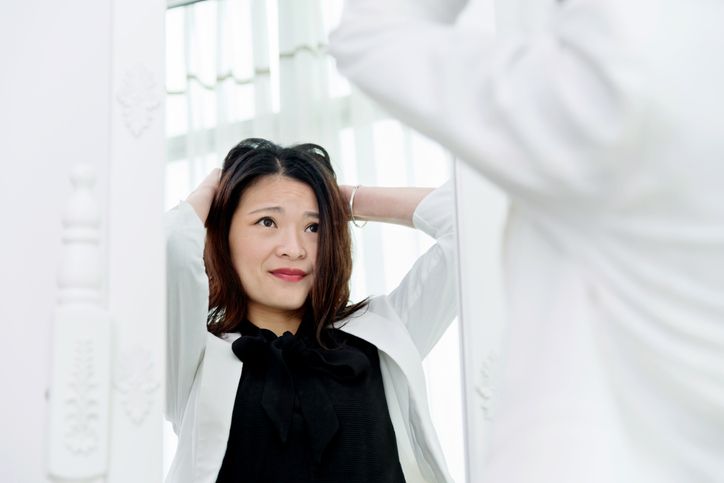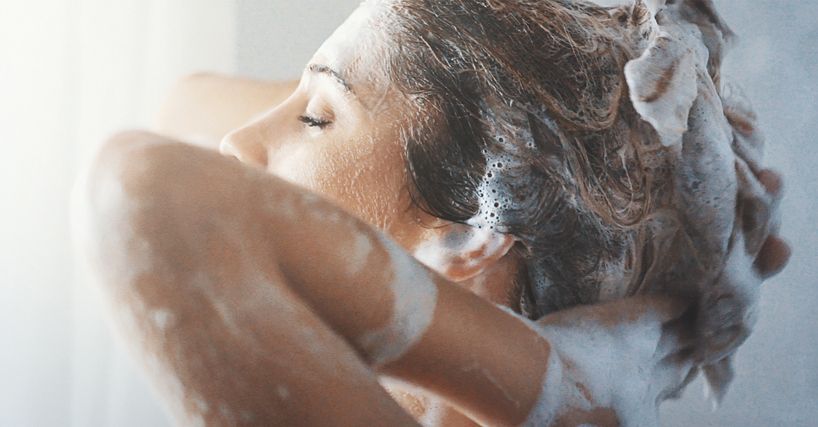
Author: Natalie Ng|Updated: 29 April 2025
Minoxidil is one of the most common treatments used to stimulate hair growth and slow down hair loss. It's FDA-approved, and studies show it helps around 60–80% of men and 50–70% of women see some level of hair regrowth—especially for those with androgenetic alopecia or female pattern hair loss. But does minoxidil work without any side effects? Not always. Most people notice mild scalp irritation, dryness, or even increased shedding at the beginning of treatment. These symptoms usually improve with consistent use and the right application technique. Whether you’re using topical minoxidil, oral minoxidil, or thinking about starting a treatment plan, it helps to know what you’re getting into. Understanding how minoxidil treatment affects your hair follicles, how it increases blood flow, and what kind of results you can realistically expect will help you make better choices—and avoid surprises. Keep reading to learn the pros, cons, and what long-term use might actually look like for most people trying to treat hair loss or regrow hair.

Pros Of Minoxidil

Minoxidil has become one of the most widely used options for treating hair loss—and for good reason. It’s backed by clinical research, approved by health authorities, and used by millions of people around the world. Whether you’re dealing with thinning hair, a receding hairline, or early signs of pattern baldness, minoxidil offers several advantages that can support long-term hair regrowth. Below are the key benefits that make minoxidil a go-to solution for many looking to slow down hair loss and encourage new growth.
1. Boosts Hair Growth
Minoxidil helps stimulate the growth of new hair by improving blood circulation to the scalp and revitalizing weakened hair follicles. Most people begin to see visible changes within four months of consistent use. It is particularly effective for treating androgenetic alopecia, female pattern hair loss, and early-stage hair thinning. While it won’t reverse complete baldness, it can support hair regrowth in thinning areas.
2. Increases Hair Density
Minoxidil doesn't just help grow new hair—it also makes existing hair appear thicker. By extending the anagen phase of the hair cycle, it promotes denser growth. Users often notice that their strands look fuller and healthier, which is especially important for people with diffuse thinning or overall volume loss.
3. Works for Most Hair Types
Minoxidil is generally safe for all natural hair types, making it accessible for a wide range of users. Whether your hair is straight, wavy, or curly, topical minoxidil can be used without altering the natural texture. However, people with color-treated hair or sensitive scalp skin may experience mild irritation or dry scalp symptoms during early use.
4. Easy to Apply
The treatment is available in topical solutions (2% or 5%) and foam versions, which can be applied directly to the scalp. Most users apply it twice a day, and the application process only takes a few minutes. You simply part your hair, apply the product to a completely dry scalp, and gently massage it in. This simplicity encourages long-term use, which is key to success.
5. Clinically Proven with High Success Rates
Studies show that 60–70% of patients respond well to minoxidil treatment. It's one of the few FDA-approved treatments for hair loss that has been tested extensively in clinical settings. Those who start using minoxidil early—especially people under age 40—tend to see better and longer-lasting results.
6. Accessible Without Prescription
Unlike other medications for treating hair loss, minoxidil is available over the counter. This makes it easier for people to start treatment without waiting for a doctor’s prescription. Still, it’s wise to consult a healthcare professional if you're unsure about the cause of your hair loss or have underlying medical conditions.
7. Can Be Used Alongside Other Treatments
Minoxidil can be safely combined with other hair loss treatments, such as finasteride, oral supplements, or laser therapy, for enhanced results. This makes it a flexible option for those building a customized treatment plan to regrow hair or manage pattern hair loss.

Cons Of Minoxidil

While minoxidil offers several benefits for hair regrowth, it’s not without its drawbacks. Like any treatment, it can cause side effects and may not work the same way for everyone. Some users experience mild irritation, while others may not see the results they hoped for—especially if treatment isn’t started early. Understanding the potential downsides can help you make a more informed decision and manage your expectations. Here are the most common concerns and limitations of using minoxidil as a hair loss treatment.
1. Common Scalp Reactions
The most frequently reported side effects of topical minoxidil include itching, dry scalp, redness, burning, or flaking in the areas where the product is applied. These are usually mild and temporary but can be uncomfortable, especially during the first few weeks.
Some people also notice changes in hair texture or color, particularly if the product drips onto other parts of the scalp or forehead. These effects tend to fade with proper application and consistent use.
2. Initial Shedding of Hair
In the early stages of treatment, minoxidil may cause increased shedding of existing hair. While this can feel alarming, it’s typically a sign the medication is starting to work. The shedding happens because minoxidil pushes older hairs out of the follicles to make room for new growth.
This phase may last anywhere from 2 to 6 weeks and usually resolves without intervention. However, some users may stop treatment out of concern, which can interrupt progress.
3. Unwanted Hair Growth
Minoxidil may cause hair to grow in unintended areas, such as the forehead, cheeks, or neck, especially if the product accidentally spreads during application. This is more common with the liquid solution than the foam, as the latter is less likely to drip.
To avoid this, always wash your hands after applying minoxidil and prevent the medication from spreading to other areas of the skin.
4. Systemic Side Effects
Though rare, systemic absorption of minoxidil (especially in high doses or with improper use) can lead to effects beyond the scalp. These may include:
• Rapid heartbeat
• Dizziness
• Swelling in hands or feet
• Sudden weight gain
• Flushing or redness
• Chest pain
• Light-headedness
• Shortness of breath
These symptoms require immediate medical attention. They’re more likely to occur with oral minoxidil or excessive application of topical minoxidil.
5. Allergic Reactions
In rare cases, users may develop a skin allergy to minoxidil or its inactive ingredients (such as propylene glycol in the solution form). Signs of an allergic reaction include:
• Rash
• Severe itching
• Swelling of the face or lips
• Difficulty breathing
If any of these symptoms appear, stop using the product immediately and consult a healthcare professional.
6. Not Effective for Everyone
While minoxidil works for many, it doesn’t help everyone. Its effectiveness depends on age, the stage of hair loss, and how consistently it’s used. People with advanced baldness or large areas of scalp exposure may not see meaningful results.
It also doesn’t treat the root causes of some hair loss conditions, such as hormonal imbalances, autoimmune diseases, or certain medications. In these cases, additional treatments may be needed.
7. Long-Term Commitment Required
Minoxidil is not a cure for hair loss—it’s a maintenance treatment. Once you stop using it, any new hair growth will likely fall out within a few months, and your hair loss condition may return to its original state.
For this reason, consistent use is necessary. This means applying it twice a day, every day, potentially for life. Skipping doses or discontinuing treatment can quickly reverse the progress made.
Read More
Book Now to Experience
F8 Hair Regrowth Treatment
1 Minute Self-Registration
Date should not be before minimal date

Support Your Minoxidil Results with F8 Hair Regrowth Treatment
While minoxidil is widely known for its ability to stimulate hair growth, supporting your scalp health with the right in-clinic treatment can make a big difference. One proven method that works well alongside minoxidil treatment is the F8 Hair Regrowth Treatment—a safe, non-invasive solution designed to improve both scalp condition and hair follicle function.
If you’re using minoxidil solution, oral minoxidil, or any other form of hair loss treatment, pairing it with F8 can enhance your results by improving how well your hair follicles absorb nutrients and respond to stimulation. The F8 treatment promotes a cleaner, healthier scalp environment, which helps you get the most out of your hair regrowth routine.
How F8 Hair Regrowth Treatment Works
The F8 Hair Regrowth Treatment combines low-energy laser therapy with a hair growth serum to activate inactive follicles and improve blood circulation in the scalp. The treatment begins with a detailed scalp analysis using magnification to assess the extent of hair loss, follicle blockage, and scalp condition.
Once the areas are identified, a therapist uses a handpiece to deliver gentle laser energy across the scalp. This process helps stimulate the hair papilla and strengthen the capillaries around the follicles, increasing blood flow and improving nutrient delivery.
After laser application, a serum rich in growth-boosting ingredients is massaged into the scalp. The laser energy helps the serum absorb effectively, hydrating the scalp, balancing oil production, and unclogging follicles—all of which support healthy hair growth and better minoxidil absorption.
Why Combine F8 with Minoxidil?
While minoxidil increases blood flow and extends the hair cycle’s anagen phase, F8 boosts its effectiveness by improving the scalp’s overall condition. If your scalp is oily, clogged, or inflamed, minoxidil may not work as efficiently. F8 cleanses, hydrates, and stimulates the scalp—creating the ideal environment for minoxidil to work better.
Together, these two treatments target both the internal and external causes of pattern hair loss, thinning hair, and scalp inflammation—leading to stronger, longer-lasting results.
Benefits of the F8 Hair Regrowth Treatment
• Non-invasive and safe for both men and women
• Enhances blood circulation to nourish hair follicles
• Unclogs pores and reduces excess scalp sebum
• Helps restore the scalp’s water-oil balance
• Encourages stronger hair strands and better volume
• No downtime—normal activity can resume immediately
F8 is suitable for those dealing with androgenetic alopecia, female pattern hair loss, receding hairline, and early-stage thinning. It’s also a great option for those experiencing slow progress with minoxidil alone.
Book Your Scalp Consultation Today
If you're serious about treating hair loss and want to get the best results from your minoxidil treatment, adding F8 Hair Regrowth Treatment to your plan could be the step that transforms your hair journey.
Book a consultation now and find out how F8 can support stronger, healthier hair—from root to tip.
New Beauty's F8 Hair Regrowth TreatmentBook Now to Experience
F8 Hair Regrowth Treatment
1 Minute Self-Registration
Date should not be before minimal date
FAQ
Can I Use Minoxidil if I'm Completely Bald With Shiny Scalp?
Minoxidil typically won't help if you're completely bald with a shiny scalp, as this indicates your hair follicles are no longer active. The medication works by revitalizing existing follicles that are still producing hair, even if it's thin or weak. You'll see better results if you start using minoxidil during early hair loss stages when you still have some hair growth, rather than after complete baldness has occurred.
Will Minoxidil Work Better if Combined With Dermarolling?
Minoxidil and dermarolling can work together to boost your hair growth potential. Studies show that combining these treatments can increase minoxidil's effectiveness by up to 50%. The micro-channels created by dermarolling allow better absorption of minoxidil into your scalp, enhancing its ability to stimulate hair follicles. Just remember to wait 24 hours after dermarolling before applying minoxidil to prevent irritation.
Does the Brand of Minoxidil Affect Its Effectiveness?
The brand of minoxidil doesn't substantially affect its effectiveness as long as it contains the same active ingredient concentration (typically 2% or 5%). Generic versions work just as well as name brands like Rogaine because they're FDA-regulated and must meet the same quality standards. You'll find that the main differences between brands are usually in the inactive ingredients, packaging, and price, so you can confidently choose based on your budget and preferred application method.
Can Women Use Men's Minoxidil Products, or Vice Versa?
Minoxidil's effectiveness isn't gender-specific. You can use either men's or women's products since the active ingredient is identical - only the concentration differs. Men's formulas typically contain 5% minoxidil, while women's versions have 2%. Though you're free to choose either, women should start with the lower concentration to minimize potential side effects, and men can stick with the stronger formula for ideal results.
Should Minoxidil Be Applied to Wet or Dry Hair?
You should apply minoxidil to dry or slightly damp hair for ideal results. When your hair is wet, the solution can become diluted and won't absorb properly into your scalp. To maximize effectiveness, guarantee your scalp is clean and dry before application, and don't wash your hair for at least four hours afterward. If you prefer to style your hair, apply minoxidil first and let it dry completely.
Recommended Articles
COPYRIGHT© NEW BEAUTY MANAGEMENT LIMITED 2025. ALL RIGHT RESERVED.




